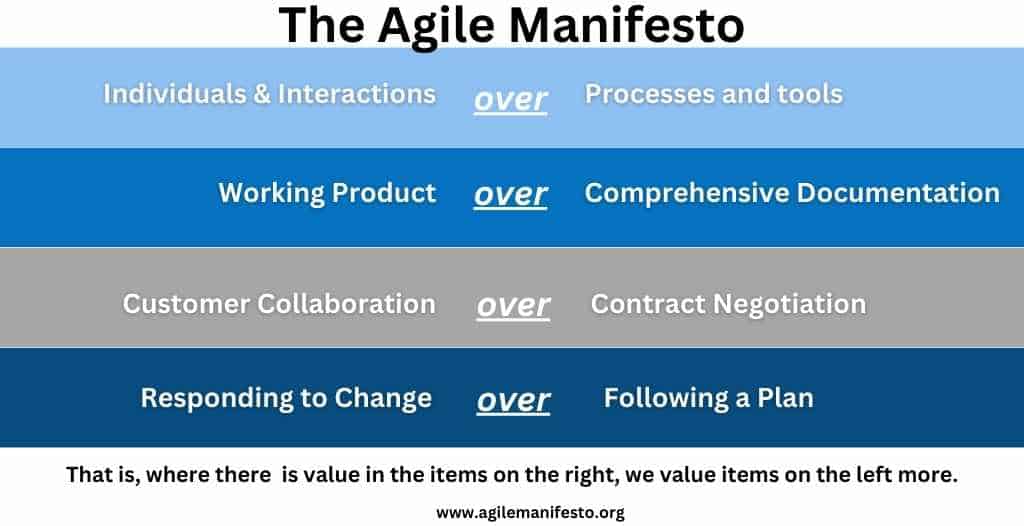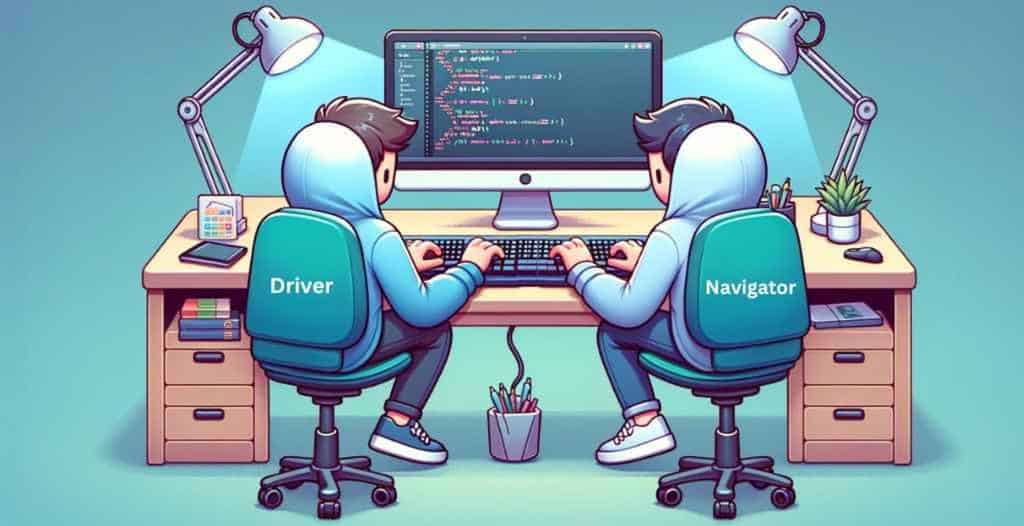This comprehensive guide will explore what pair programming is, the different styles for pair programmers, the benefits, tools, and best practices you can use to get higher quality code.
Table of Contents
ToggleIf you’re new to this technique for agile software development, or looking to refine your skills, or choose pair programming styles, this article will provide you with valuable insights and advice on what to do next.
What Is Pair Programming?
Pair programming, a common practice in agile software development practices, is an approach where two software developers work together when writing code.
They work collaboratively, leveraging each other’s skillsets, including brainstorming, problem-solving, and continuous learning.
The Essentials: How Does Pair Programming Work?
Pair programming, like most agile software development techniques, prioritizes people and interactions over processes and tools, making it an ideal approach for teams striving for innovation and excellence in developing software.
At the heart of pair programming are two roles: the driver and the navigator. These are often referred to as the Pair Programmers.
Pair Programmers
The driver is the one who writes code, actively translating thoughts into code.
The navigator, on the other hand, reviews each line of code, contemplating the broader implications and potential improvements.
This partnership is not static; the two programmers involved frequently switch roles, ensuring a dynamic and engaging process.
Effective pair programming goes beyond mere coding. It’s about communication, collaboration, the fusion of two developers’ strengths, and the synergy that arises when two minds focus on a single problem.
The technique is often seen as a part of extreme programming, along with a flat management structure and very short development cycles.
Is Pair Programming Part of Agile?
Pair programming is a highly regarded technique in Agile software development.

A Powerful Agile Software Development Technique
Programming in pairs supports several aspects of Agile:
Collaboration and Communication
Agile emphasizes collaboration and communication, and pair programming embodies this by having two developers work closely together in a collaborative environment where knowledge and ideas are constantly exchanged.
Quality Improvement
With two developers reviewing the code as it’s written, the risk of introducing bugs reduces. This immediate review process leads to higher quality of code, aligning with Agile’s focus on delivering high-quality, functional software.
Knowledge Sharing and Skill Enhancement
Pair programming facilitates the transfer of knowledge between team members. More experienced developers can mentor less experienced ones, promoting continuous learning and skill development, which are key aspects of Agile.
Problem Solving and Innovation
Two minds working together can solve complex problems more efficiently and come up with more innovative solutions than one working alone. This collaborative problem-solving approach is at the heart of Agile methodologies.
Reduced Risk of Blockers
With two people working on the same problem, the risk of getting stuck is reduced. If one developer is unsure how to proceed, the other is likely to be able to help, keeping the project moving forward in line with Agile’s iterative progress.
Enhanced Team Dynamics
Pair programming helps build stronger team dynamics and trust. It encourages developers to communicate more effectively, a key component in Agile’s emphasis on team interactions.
Resilience to Personnel Changes
Since knowledge about the codebase and the project is shared among team members, pair programming makes the team more resilient to changes, such as team members leaving or joining
Focus and Discipline
Working in pairs can increase focus and discipline, as developers are less likely to get distracted. This leads to more efficient use of time, which is crucial in the time-boxed sprints of Agile methodologies.
What are Pair Programming Styles and Techniques?
Pair programming is not a one-size-fits-all approach. There are various pair programming styles, each suited to different team dynamics and project requirements.
Choosing the right pair programming style is crucial for success. Each pairing style has its unique benefits and fit to different project stages and team structures.
How to choose pair programming styles
This section will help you to choose which of the many pair programming styles is best for your organization.
Driver-Navigator Programming Style
The traditional driver-navigator model is the most fundamental form of pair programming. In this style, one programmer (the driver) writes the code while the other (the navigator) reviews each line of code as it is written.

This approach allows for real-time code review and immediate feedback, resulting in fewer coding errors and higher quality output.
The navigator not only reviews the code but also thinks ahead, plans the next steps, and strategizes about broader issues like design and architecture.
This style encourages active communication and collaboration, as both programmers discuss and resolve problems together.
The roles are often switched at regular intervals to keep the session dynamic and engaging.
Ping Pong Style
In the Ping Pong style of pair programming, which is closely associated with test-driven development (TDD), the roles of the two programmers alternate between writing tests and writing code to pass those tests.

One programmer starts by writing a failing test case. Then, the other programmer writes the necessary code to pass the test.
After the test passes, the roles switch.
This method ensures that the software is developed with testing in mind from the outset, leading to robust, well-tested code.
It also keeps both programmers actively engaged and ensures that both are equally familiar with the codebase and the test suite.
Expert-Expert Pairing
In this example of pair programming styles, two advanced programmers with a high level of expertise collaborate.
This pairing often leads to innovative solutions and complex problem-solving, as both programmers bring significant experience and knowledge to the table.
This style is particularly effective in tackling highly complex, critical, or innovative parts of a project, where the combined expertise can significantly contribute to the quality and efficiency of the output.
The challenge in this pair programming style is to ensure that both experts are able to contribute equally and that their collaboration leads to consensus rather than conflict.

Expert-Novice Pairing
This style pairs a more experienced programmer (the expert) with a less experienced one (the novice).
The primary goal here is knowledge transfer and mentorship.
The novice benefits from the expert’s guidance, gaining insights into best practices, problem-solving strategies, and coding techniques.
For the expert, this pairing can offer fresh perspectives and reinforce their understanding of the fundamentals. This style is beneficial for onboarding new team members and building a skilled and cohesive team.
Novice-Novice Pairing
Pairing two junior developers can be challenging but also a valuable learning experience.
In this setup, both programmers can explore solutions together, learn from each other’s perspectives, and develop their problem-solving skills collaboratively.
While this style might initially lead to slower progress, it encourages a deep understanding of the work as both programmers are required to think critically and independently.
It is also beneficial for building confidence in new programmers, as they are placed in a position of equal responsibility and contribution.
What are the Benefits of Pair Programming when Developing Software?
Pair programming can leverage several benefits:
Risk Mitigation:
Pair programming significantly reduces the risk of project delays. When two programmers work together, they can quickly address and resolve any blockers or complex issues, ensuring smoother project progress.
Diverse Perspectives:
Bringing together two programmers often means combining different perspectives and experiences. This diversity can lead to more holistic and well-rounded solutions, as different viewpoints are considered during development.
Code Ownership and Consistency:
In pair programming, code is no longer associated with a single individual, promoting a sense of collective ownership and responsibility. This approach encourages consistency in coding standards and practices across the team.
Reduced Technical Debt:
With continuous review and collaborative problem-solving, pair programming helps in writing cleaner and more maintainable code, thereby reducing technical debt over time.
Boosts Agile Practices:
Pair programming aligns perfectly with Agile methodologies, emphasizing collaboration, flexibility, and iterative development. It reinforces Agile principles, enhancing the team’s ability to adapt and respond to change quickly.
Challenges and Solutions in Pair Programming
While pair programming is beneficial, it’s not without challenges. Understanding and addressing these challenges is crucial for a successful pair programming experience.
Differing Work Styles
Challenge
Not all programmers work in the same way. The development process can be impacted when work styles and pace significantly differ.
Solution
Establish common ground rules between the two developers at the beginning of each session. Agree on things like coding standards, task breakdown, and a schedule that suits both parties. This helps in synchronizing work styles and expectations.
Communication Barriers
Challenge
Effective communication is key, but can be a challenge, especially in diverse and multi-cultural teams.
Solution
Encourage the development of good communication skills through training and workshops. Using tools that facilitate clear and efficient communication, such as collaborative coding platforms, can also help.
Balancing Workloads
Challenge
Ensuring that both members of the pair are equally engaged and contributing can be challenging.
Solution
Regularly rotate the roles of driver and navigator. This rotation helps in balancing the workload and ensures that both partners are equally involved in the coding and decision-making processes.
Over-Reliance on One Programmer
Challenge
Sometimes, one programmer may dominate the session, which can stifle the learning and contributions of the other.
Solution
Foster an environment of mutual respect where both programmers are encouraged to contribute equally. Setting specific times for each programmer to lead the session can help in ensuring balanced participation.
Best Practices for Pair Programming
Pair programming, when done right, can significantly enhance the productivity and quality of software development.
Here are some examples of best practices in pair programming:
Clear Role Definition
Driver and Navigator Roles
Clearly define the roles of the driver (who writes the code) and the navigator (who reviews and guides the process). Regularly switch roles to keep the session dynamic and engage both programmers.
Active Involvement
Ensure both participants are actively involved, with the navigator not only observing but also thinking ahead and planning.
Effective Communication
Open and Continuous Dialogue
Maintain an open line of communication where ideas and concerns can be freely discussed.
Listening Skills
Both participants should practice active listening, acknowledging the other’s ideas and building upon them.
Choose the Right Pair
Complementary Skills
Pair programmers with complementary skills to maximize learning and effectiveness.
Personality Matching
Consider personality compatibility for a smooth collaboration.
Use Appropriate Tools
Collaborative Tools
Use tools that facilitate real-time collaboration, especially for remote pair programming.
Shared Environment
Ensure both programmers have access to the same development environment and resources.
Focus on Learning
Knowledge Sharing
Encourage the sharing of knowledge and techniques between the pair.
Continuous Improvement
Regularly reflect on the pair programming sessions and seek ways to improve.
Manage Time and Breaks
Timed Sessions
Keep pair programming sessions to a manageable length to prevent fatigue.
Regular Breaks
Take regular breaks to maintain focus and prevent burnout.
Code Quality and Reviews
Focus on Quality
Prioritize writing quality code over speed.
Regular Reviews
Periodically review the code together to ensure it meets project standards and best practices.
Flexibility and Adaptability
Adjusting Approaches
Be willing to adjust approaches based on the task at hand and feedback from the pair.
Open to Change
Be open to changing pairs and strategies as projects and tasks evolve.
Setting Goals and Objectives
Clear Objectives
Start each session with clear objectives and goals.
Task Breakdown
Break down tasks into manageable chunks to keep the pair focused and productive
Case Studies: Successful Pair Programming Implementations
The implementation of pair programming in many organizations has led to significant improvements in software development processes, team dynamics, and overall project outcomes. Here are some example case studies:
TribalScale and McCain Foods
Background
Facing challenges including lack of context and knowledge transfer, and gaps in business logic coverage.
Implementation
Adopted Pair Programming and Test Driven Development (TDD).
Outcome
The next project was delivered two weeks ahead of schedule with remarkable improvements in coding quality, coherence, and thoroughness. The approach facilitated collaborative planning, immediate testing and feedback, improved documentation, and knowledge transfer [“].
Iyzico
Background
A fintech startup looking to reduce risk and scale effectively.
Implementation
Used pair programming to have more eyes on their code for catching bugs and errors.
Outcome
Enhanced scalability and better management of risks, along with improvements in testing, engineering orientation, and domain knowledge [“].
Salesforce
Background
Wanted to improve their remote onboarding process.
Implementation
Introduced remote pair programming.
Outcome
Experienced engineers teach relevant code to newer coders, enhancing the onboarding experience and ensuring effective knowledge transfer [“].
Square
Background
Wanted to improve the quality of code.
Implementation
Enforced a rule where every piece of code going to production was seen by at least two engineers.
Outcome
Ensured high quality of code and robustness. Pair programming plays a role in their hiring process [“].
Advanced Strategies for Experienced Programmers
Experienced programmers can significantly develop the pair programming process, bringing advanced strategies and deeper insights into the software development workflow.

Here’s how they can leverage their expertise:
Complex Problem Solving
Collaborative Analysis
When faced with complex problems, two experienced minds can analyze and dissect issues more effectively than one. This collaboration can lead to a more thorough understanding of the problem and its potential solutions.
Diverse Problem-Solving Approaches
Experienced programmers often come with a repertoire of problem-solving strategies. When these are combined in a pair programming setting, it can lead to more innovative and effective solutions.
Shared Expertise
Each programmer brings their own unique set of skills and knowledge. Sharing this expertise can uncover new angles and approaches to complex problems that might not be apparent to a single developer.
Innovative Solutions
Synergy of Skills and Experiences
The fusion of different backgrounds and experiences can spark creativity, leading to more innovative solutions. Pair programming in this context acts as a melting pot for new ideas.
Rapid Prototyping and Feedback
Experienced pairs can quickly prototype ideas and provide immediate feedback, accelerating the innovation process. This rapid iteration can lead to the development of groundbreaking features or solutions.
Cross-Pollination of Industries
Programmers with experience in different industries can bring unique insights, leading to innovative solutions that transcend traditional boundaries.
Mentoring and Leadership
Guidance and Knowledge Transfer
More experienced programmers can guide less experienced ones, sharing insights, best practices, and industry knowledge. This mentorship enriches the entire team’s skill set.
Fostering a Culture of Continuous Learning
By setting an example of continuous learning and improvement, experienced programmers can foster a culture that values growth and education, which is vital for the dynamic field of software development.
Leadership by Example
Experienced programmers can lead by example, demonstrating best practices in coding, testing, and design. Their approach to problem-solving and collaboration can serve as a model for the entire development team.
Pair Programming Tools
Pair programming, especially in a remote or hybrid work environment, relies heavily on tools that facilitate collaboration, communication, and code sharing.
Each of these tools has unique features that cater to different needs, like IDE integration, real-time collaboration, screen sharing, or cloud-based environments.
The choice of tool depends on the specific requirements of the team, such as the programming languages used, the complexity of the projects, and whether the team is co-located or distributed.
These tools help overcome the geographical barriers in remote pair programming, ensuring effective collaboration and efficient problem-solving, regardless of the team members’ locations.
Here’s an overview of some popular pair programming tools, each catering to different aspects of the collaborative coding process:
Code Collaboration Platforms
Visual Studio Code Live Share
An extension for Visual Studio Code that enables real-time collaborative editing and debugging. It allows multiple developers to join a session, share a server, and edit code simultaneously.
Atom Teletype
Offers real-time collaboration for Atom users. It allows a developer to share their workspace with team members, who can then edit and collaborate on the code in real-time.
Integrated Development Environments (IDEs) with Collaboration Features
JetBrains Tools (e.g., IntelliJ IDEA, PyCharm)
JetBrains IDEs support collaborative coding through plugins like Code With Me, enabling developers to share their project view and codebase for real-time collaboration.
Eclipse with Saros
An open-source IDE that, with the Saros plugin, allows for distributed pair programming. Saros offers features like synchronized file editing and a shared clipboard.
Communication and Screen-Sharing Tools
Slack with Screenhero (now integrated into Slack calls)
Slack, widely used for team communication, includes features for screen sharing and voice calls, which are crucial for discussing and reviewing code in pair programming sessions.
Zoom
While primarily a video conferencing tool, Zoom’s screen sharing and remote control features make it a useful tool for pair programming, especially for teams already using it for meetings
Cloud-Based Development Environments
GitHub Codespaces
Provides a complete, configurable and collaborative integrated development environment, hosted in the cloud, and accessible through a browser or Visual Studio Code. This tool is ideal for teams who want to quickly spin up dev environments without local setup.
Replit
An online coding platform that supports several programming languages and provides collaborative coding features, making it suitable for educational purposes and quick prototyping.
Remote Pair Programming Specific Tools
Tuple
A tool designed specifically for remote pair programming. It focuses on low-latency screen sharing and high-quality audio, creating a smooth pairing experience for remote teams.
CoScreen
Enhances remote collaboration by allowing multiple users to share screens and interact with shared windows simultaneously, making it effective for complex pair programming sessions
Pair Programming and Artificial Intelligence
Pair programming is poised for significant transformation though the application of Artificial Intelligence, making it more efficient, insightful, and easily tailored to individual and team needs.
The combination of human creativity and AI’s analytical power will unlock new frontiers in software development, enhancing both the process and the product.
Here are some possibilities for the future:
AI as a programmer
The future of pair programming will see AI playing the role of an assistant or even a virtual pair programmer in practices for agile software development.
AI as a consultant
AI can advise you on selecting pair programming styles that best suit your circumstances.
AI as a third eye
AI can provide real-time code suggestions, error detection, and optimization tips, effectively acting as a third eye in the programming process.
AI-Driven Code Reviews and Insights
AI tools can analyze code in real-time during pair programming sessions, providing insights and suggestions that might be overlooked by human eyes. This could lead to not only more robust code but also a deeper understanding and learning for the programmers involved.
Customized Learning and Development
AI can personalize learning experiences during pair programming by identifying individual programmers’ strengths and weaknesses. This personalized approach can accelerate the learning curve, especially for less experienced programmers.
Facilitation of Remote Pair Programming
With the rise of remote work, AI can be instrumental in bridging the physical gap in pair programming. AI-driven tools can ensure seamless collaboration, simulate in-person interaction, and provide a more intuitive coding environment for remote teams.
Predictive Analysis for Pair Compatibility
AI can analyze past interactions and quality of code to suggest the most compatible pair programming teams. This predictive pairing can lead to more productive sessions and better team dynamics.
Summary
Every organization developing software should seriously consider adopting pair programming.
It is a proven technique for enhancing code quality, boosting productivity, facilitating knowledge sharing, developing skills, improving team learning, and more.
If you haven’t already embraced it, then now is the time to start if you want to improve how to develop software and the resulting product.




